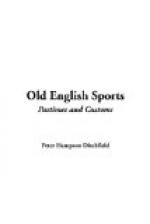The joust (or just) differed from tournament, because in the former only lances were used, and only two knights could fight at once. It was not considered quite so important as the grand feat of arms which I have just described, but was often practised when the more serious encounter had finished. Lances or spears without heads of iron were commonly used, and the object of the sport was to ride hard against one’s adversary and strike him with the spear upon the front of the helmet, so as to beat him backwards from his horse, or break the spear. You will gather from these descriptions that this kind of sport was somewhat dangerous, and that men sometimes lost their lives at these encounters. In order to lessen the risk and danger of the two horses running into each other when the knights charged, a boarded railing was erected in the midst of the lists, about four or five feet high. The combatants rode on separate sides of this barrier, and therefore could not encounter each other except with their lances.
[Illustration: A TOURNAMENT.]
In the days of chivalry ladies were held in high honour and respect. It was their privilege to assign the prizes to those who had distinguished themselves most in the tournament. They were the arbiters of the sport; and, indeed, the jousts were usually held in honour of the ladies, who received as their right the respect and devotion of all true knights. This respect for women had a softening and ennobling influence, which was of great value in times when such influences were rare. It was probably derived (according to a French writer) from our ancestors, the Germans, “who attributed somewhat of divinity to the fair sex.” It is the sign of a corrupt age and degraded manners when this respect ceases to be paid.
Only men of noble family, and who owned land, were allowed to take part in the jousts or tournament; but the yeomen and young farmers used to practise similar kinds of sport, such as tilting at a ring, quintain, and boat jousts, which have already been mentioned in a preceding chapter. Richard I., the lion-hearted king, was a great promoter of these martial sports, and appointed five places for the holding of tournaments in England, namely, at some place between Salisbury and Wilton, between Warwick and Kenilworth, between Stamford and Wallingford, between Brackley and Mixbury, and between Blie and Tykehill. But in almost every part of England tournaments or jousts have been held, and scenes enacted such as I have described. Sometimes two knights would fight in mortal combat. If one knight accused the other of crime or dishonour, the latter might challenge him to fight with swords or lances, and, according to the superstition of the times, the victor was considered to be the one who spoke the truth. But this ordeal combat was far removed from the domain of sport.




